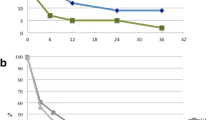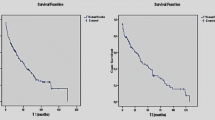Abstract
Purpose
The aim of this study is to analyze rates of ventriculopleural (VPL) shunt failure and complications among patients with pediatric hydrocephalus, and to analyze which factors may predict early (< 1 year) or late (> 1 year) VPL shunt failure in this sample.
Methods
A retrospective chart review was conducted of all consecutive VPL shunt placements from 2000 to 2019 at our institution. Data was collected on patient characteristics, shunt history, and shunt type. Primary endpoints include rates of VPL shunt survival and rates of symptomatic pleural effusion. The Kaplan–Meier method was used to calculate shunt survival, and Fisher’s exact test and t-test were used to compare differences between categorical variables and means, respectively (p < 0.05).
Results
Thirty-one patients with pediatric hydrocephalus underwent VPL shunt placement (mean age 14.2 years). Of the 27 patients with long-term follow-up (mean 46 months), VPL shunt revision was required in 19, seven of which were due to pleural effusion. Overall shunt survival rates at 1, 3, 5, and 7 years were 76%, 62%, 55%, and 46%, respectively. Mean duration of shunt survival was 26.74 months. Overall pleural effusion rate was 26%. No patient-specific factors, including shunt valve type, were significantly associated with shunt survival, risk of early revision, or risk of pleural effusion.
Conclusions
Our results are comparable to those reported in the literature and represent one of the largest case series on the topic. VPL shunts are a viable second-line option when ventriculoperitoneal (VP) shunt placement is not possible or desirable, though there are high rates of shunt revision and pleural effusion.


Similar content being viewed by others
References
Isaacs AM, Riva-Cambrin J, Yavin D, Hockley A, Pringsheim TM, Jette N, Lethebe BC, Lowerison M, Dronyk J, Hamilton MG (2018) Age-specific global epidemiology of hydrocephalus: systematic review, metanalysis and global birth surveillance. PLoS ONE 13(10):e0204926
Paff M, Alexandru-Abrams D, Muhonen M, Loudon W (2018) Ventriculoperitoneal shunt complications: a review. Interdiscip Neurosurg 13:66–70
Wong T, Gold J, Houser R, Herschman Y, Jani R, Goldstein I (2021) Ventriculopleural shunt: review of literature and novel ways to improve ventriculopleural shunt tolerance. J Neurol Sci 428:117564
Reddy GK, Bollam P, Caldito G (2014) Long-term outcomes of ventriculoperitoneal shunt surgery in patients with hydrocephalus. World Neurosurg 81(2):404–410
Heile B (1914) Sur chirurgischen Behandlung des Hydrocephalus internus durch Ableitung der Cerebrospinalflüssigkeit nach der Bauchhöhle und nach der Pleurakuppe. Arch Klin Chir 105:501–516
Ransohoff J (1954) Ventriculo-pleural anastomosis in treatment of midline obstructional neoplasms. J Neurosurg 11(3):295–298
Ransohoff J, Shulman K, Fishman RA (1960) Hydrocephalus: a review of etiology and treatment. J Pediatr 56(3):399–411
Chang C, Liu R, Liu C, Hwang W, Hsieh H, Liao S, Su H, Chang C, Chang H, Wang S (2007) Pleural effusion resulting from ventriculopleural shunt demonstrated on radionuclide shuntogram. Clin Nucl Med 32(1):47
Dalphy A, Burkett A (2018) Pleural cerebrospinal fluid shunting causing trapped lung: a respiratory physician’s approach to management and prevention. Respir Med Case Rep 25:303–305
Donnelly N, Jayamohan J, Moore AJ (2001) Delayed complication of a ventriculopleural shunt. Br J Neurosurg 15(2):193–194
Grunberg J, Rebori A, Verocay MC, Ramela V, Alberti R, Cordoba A (2005) Hydrothorax due to ventriculopleural shunting in a child with spina bifida on chronic dialysis: third ventriculostomy as an alternative of cerebrospinal diversion. Int Urol Nephrol 37(3):571–574
Hoffman HJ, Hendrick B, Humphreys RP (1983) Experience with ventriculo-pleural shunts. Pediatr Neurosurg 10(6):404–413
Irani F, Elkambergy H, Okoli K, Abou Abdallah DS (2009) Recurrent symptomatic pleural effusion due to a ventriculopleural shunt. Respir Care 54(8):1112–1114
Kupeli E, Yilmaz C, Akçay Ş (2010) Pleural effusion following ventriculopleural shunt: case reports and review of the literature. Ann Thorac Med 5(3):166
Sanders DY, Summers R, DeRouen L (1997) Symptomatic pleural collection of cerebrospinal fluid caused by a ventriculopleural shunt. South Med J 90(3):345–346
Venes JL (1974) Pleural fluid effusion and eosinophilia following ventriculo-pleural shunting. Dev Med Child Neurol 16(1):72–76
Wu TS, Kuroda R (2011) Tension hydrothorax in a pediatric patient with a ventriculopleural shunt. J Emerg Med 40(6):637–639
Christian EA, Quezada JJ, Melamed EF, Lai C, McComb JG (2021) Ventriculopleural shunts in a pediatric population: a review of 170 consecutive patients. J Neurosurg Pediatr 28(4):450–457
Ajlan B, Maghrabi Y, Mokhtar G, Baeesa S (2022) Timing of ventriculoatrial shunt removal on renal function recovery of patients with shunt nephritis: case report and systematic review. Clin Neurol Neurosurg 218:107279
Babigumira M, Huang B, Werner S, Qunibi W (2017) Delayed manifestation of shunt nephritis: a case report and review of the literature. Case Rep Nephrol
Gmeiner M, Wagner H, van Ouwerkerk WJ, Sardi G, Thomae W, Senker W, Holl K, Gruber A (2020) Long-term outcomes in ventriculoatrial shunt surgery in patients with pediatric hydrocephalus: retrospective single-center study. World Neurosurg 138:e112–e118
Hanak BW, Bonow RH, Harris CA, Browd SR (2017) Cerebrospinal fluid shunting complications in children. Pediatr Neurosurg 52(6):381–400
Harland TA, Winston KR, Jovanovich AJ, Johnson RJ (2018) Shunt nephritis: an increasingly unfamiliar diagnosis. World Neurosurg 111:346–348
Völker LA, Burkert K, Scholten N, Grundmann F, Kurschat C, Benzing T, Hampl J, Becker JU, Müller RU (2019) A case report of recurrent membranoproliferative glomerulonephritis after kidney transplantation due to ventriculoatrial shunt infection. BMC Nephrol 20:1–6
Munshi I, Lathrop D, Madsen JR, Frim DM (1998) Intraventricular pressure dynamics in patients with ventriculopleural shunts: a telemetric study. Pediatr Neurosurg 28(2):67–69
Martinez-Lage JF, Torres J, Campillo H, Sanchez-del-Rincon I, Bueno F, Zambudio G, Poza M (2000) Ventriculopleural shunting with new technology valves. Child’s Nerv Syst 16(12):867–871
Jones RFC, Currie BG, Kwok BCT (1988) Ventriculopleural shunts for hydrocephalus: a useful alternative. Neurosurgery 23(6):753–755
Hasegawa H, Rinaldo L, Meyer FB, Lanzino G, Elder BD (2020) Reevaluation of ventriculopleural shunting: long-term efficacy and complication rates in the modern era. World Neurosurg 138:e698–e704
Bakhaidar M, Wilcox JT, Sinclair DS, Diaz RJ (2022) Ventriculoatrial shunts: review of technical aspects and complications. World Neurosurg 158:158–164
Craven C, Asif H, Farrukh A, Somavilla F, Toma AK, Watkins L (2016) Case series of ventriculopleural shunts in adults: a single-center experience. J Neurosurg 126(6):2010–2016
Richardson MD, Handler MH (2013) Minimally invasive technique for insertion of ventriculopleural shunt catheters. J Neurosurg Pediatr 12(5):501–504
McGirt MJ, Zaas A, Fuchs HE, George TM, Kaye K, Sexton DJ (2003) Risk factors for pediatric ventriculoperitoneal shunt infection and predictors of infectious pathogens. Clin Infect Dis 36(7):858–862
Gehlen M, Eklund A, Kurtcuoglu V, Malm J, Schmid Daners M (2017) Comparison of anti-siphon devices—how do they affect CSF dynamics in supine and upright posture? Acta Neurochir 159(8):1389–1397
Huang AP, Kuo LT, Lai DM, Yang SH, Kuo MF (2022) Antisiphon device: a review of existing mechanisms and clinical applications to prevent overdrainage in shunted hydrocephalic patients. Biomed J 45:95–108
Panagopoulos D, Stranjalis G, Gavra M, Boviatsis E, Korfias S (2022) Shunt over-drainage, slit ventricle syndrome, programmable valves and anti-siphon devices. A narrative review of a multifactorial and intractable problem. J Integr Neurosci 21(3):84
Ratliff M, Unterberg A, Bächli H (2016) Ventriculo-bipleural shunt as last resort in a 4-year-old child in whom a VP and VA shunt failed. J Neurosurg Pediatr 17(3):285–288
Author information
Authors and Affiliations
Contributions
Daniel Oyon, Mandana Behbahani, and Tadanori Tomita devised the study design. Daniel Oyon and Shelly Sharma wrote the main manuscript text. Daniel Oyon, Shelly Sharma, Luis Fernandez, and William Gibson prepared the tables and figures. Daniel Oyon and Shelly Sharma conducted the statistical analysis. Dana Coons, Tatiana Pundy, Luis Fernandez, and William Gibson collected the individual patient data. All authors reviewed the manuscript.
Corresponding author
Ethics declarations
Conflict of interest
The authors declare no competing interests.
Additional information
Publisher's Note
Springer Nature remains neutral with regard to jurisdictional claims in published maps and institutional affiliations.
The work presented is original and has not been published elsewhere nor is it being considered for publication at another journal
Rights and permissions
Springer Nature or its licensor (e.g. a society or other partner) holds exclusive rights to this article under a publishing agreement with the author(s) or other rightsholder(s); author self-archiving of the accepted manuscript version of this article is solely governed by the terms of such publishing agreement and applicable law.
About this article
Cite this article
Oyon, D.E., Behbahani, M., Sharma, S. et al. Ventriculopleural shunt outcomes for pediatric hydrocephalus: a single-institution experience. Childs Nerv Syst 39, 2105–2113 (2023). https://doi.org/10.1007/s00381-023-05928-x
Received:
Accepted:
Published:
Issue Date:
DOI: https://doi.org/10.1007/s00381-023-05928-x




